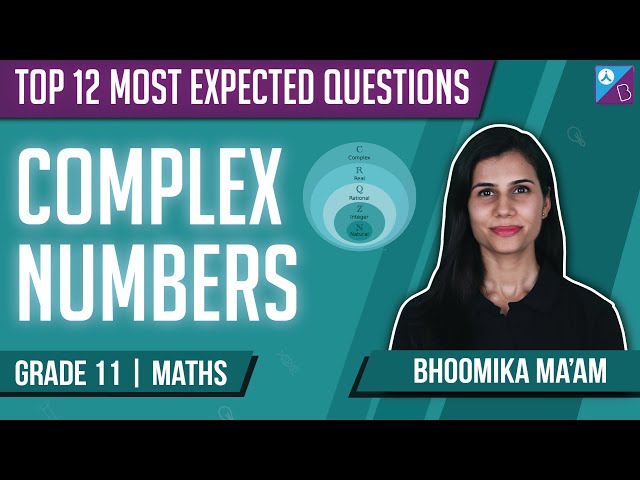Complex numbers are algebraic expressions which have real and imaginary parts. If the real part of a complex number is 0, then it is called a “purely imaginary number”. This article gives insight into complex numbers definition and complex numbers solved examples for aspirants so that they can start with their preparation.
Complex Number Definition
A number of the form z = x + iy where x is the real part, y is the imaginary part and x, y belong to a set of real numbers.
Representation of a Complex Number

The polar form of z : x = r cos θ, y = r sin θ
The exponential form of z : z = r eiθ (where eiθ = cos θ + i sin θ)
Modulus and Argument of a Complex Number
If z = x + iy, then the modulus is denoted by
The properties of the modulus of complex numbers are as follows:
The identities of arguments are as follows:
Conjugate of a Complex Number
A number consisting of an equally real and imaginary part which is equal in magnitude but with opposite signs can be termed a complex conjugate of a complex number.
The properties of the conjugate of complex numbers are as follows:
Let z and w be two complex numbers.
Algebra of Complex Numbers
The different rules for operations on complex numbers are as follows:
Equality of Complex Numbers
Consider two complex numbers z1 = (a+bi) and z2 = (c + di). They are said to be equal if their real and imaginary parts are equal, that is
Related articles
Representation of a Complex Number
Complex Numbers – Top 12 Most Important and Expected JEE Questions

Complex Number Examples
Solved examples on complex numbers are given below.
Example 1: If z1, z2, z3 are the vertices of an equilateral triangle ABC, such that |z1 − i| = |z2 − i| = |z3 − i|, then what is the value of |z1 +z2 + z3|?
Solution:
|z1 − i| = |z2 − i| = |z3 − i|
Hence, z1, z2, and z3 lie on the circle whose centre is i.
Also, the circumcenter coincides.
[z1 + z2 + z3] / 3 = i⇒ |z1 + z2 + z3| = 3
Example 2: What is the value of λ if the curve y = (λ + 1)x2 + 2 intersects the curve y = λx + 3 at exactly one point?
Solution:
As (λ + 1)x2 + 2 = λx + 3 has only one solution, so D = 0
⇒ λ2 − 4(λ + 1)(−1) = 0
Or
Λ2 + 4λ + 4 = 0
Or (λ + 2)2 = 0
Therefore, λ = −2
Example 3: If k + ∣k + z2∣ = |z|2 ;(k ∈ R−), what is the possible argument of z?
Solution:
|k + z2| = |z2| − k = |z2| + |k|
⇒ k, z2 and 0 + i0 are collinear
⇒ arg (z2)= arg (k)
⇒ 2 arg (z) = π
⇒ arg (z) = π/2
Example 4: Let a≠0 and p(x) be a polynomial of degree greater than 2. If p(x) leaves remainders a and ?a when divided respectively, by x + a and x – a, the remainder when p(x) is divided by x2 − a2 is?
Solution:
We are given that p(-a) = a and p(a) = -a
(When a polynomial f(x) is divided by x – a, remainder is f[a]),
Let the remainder, when p(x) is divided by x2 − a2, be Ax+B.
Then,
p(x) = Q(x)(x2 − a2) + Ax + B ….. (1)
Where Q(x) is the quotient.
Putting x = a and -a in (1), we get
p(a) = 0 + Aa + B
⇒ −a = Aa + B …. (2)
And p(−a) = 0 − aA + B
⇒ a = −aA + B …….(3)
Solving (2) and (3), we get
B = 0 and A = -1
Hence, the required remainder is -x.
Example 5: If the roots of the equation x2+2ax+b=0 are real and distinct and they differ by at most 2m, then at what interval does b lie?
Solution:
Let the roots be α, β.
∴α + β = −2a and αβ = b
Given, |α − β| ≤ 2m
or |α − β|2 ≤ (2m)2 or(α + β)2 − 4ab ≤ 4m2 or 4a2 − 4b ≤ 4m2
⇒ a2 − m2 ≤ b and discriminant D > 0 or 4a2 − 4b > 0
⇒ a2 − m2 ≤ b and b < a2.
Hence, b ∈ [a2−m2,a2).
Example 6: Find the conjugate of (2 – i)(1 + 2i)/(2 + 3i)(3 – 2i).
Solution:
We have (2-i)(1+2i)/(2+3i)(3-2i) = (2-i+4i+2)/ (6+9i-4i+6)
= (4+3i) / (12+5i)
Multiply the numerator and denominator by (12-5i).
(4+3i)(12-5i) / (12+5i)(12-5i) = (48+36i-20i+15)/(144+25)
= (63+16i) / 169
Hence, the conjugate is (63+16i) / 169
Example 7: Solve the equation x2+3x+9 = 0
Solution:
We have x2+3x+9 = 0
b2-4ac = 32-4×1×9 = 9-36 = -27 < 0
∴ x = (-3+√-27)/2 or (-3-√-27)/2 (Using equation [-b±√(b2-4ac)]/2a)
= (-3+√27 i)/2 or (-3-√27 i)/2
Complex Numbers – Important Topics

Complex Numbers – Important Questions


Comments